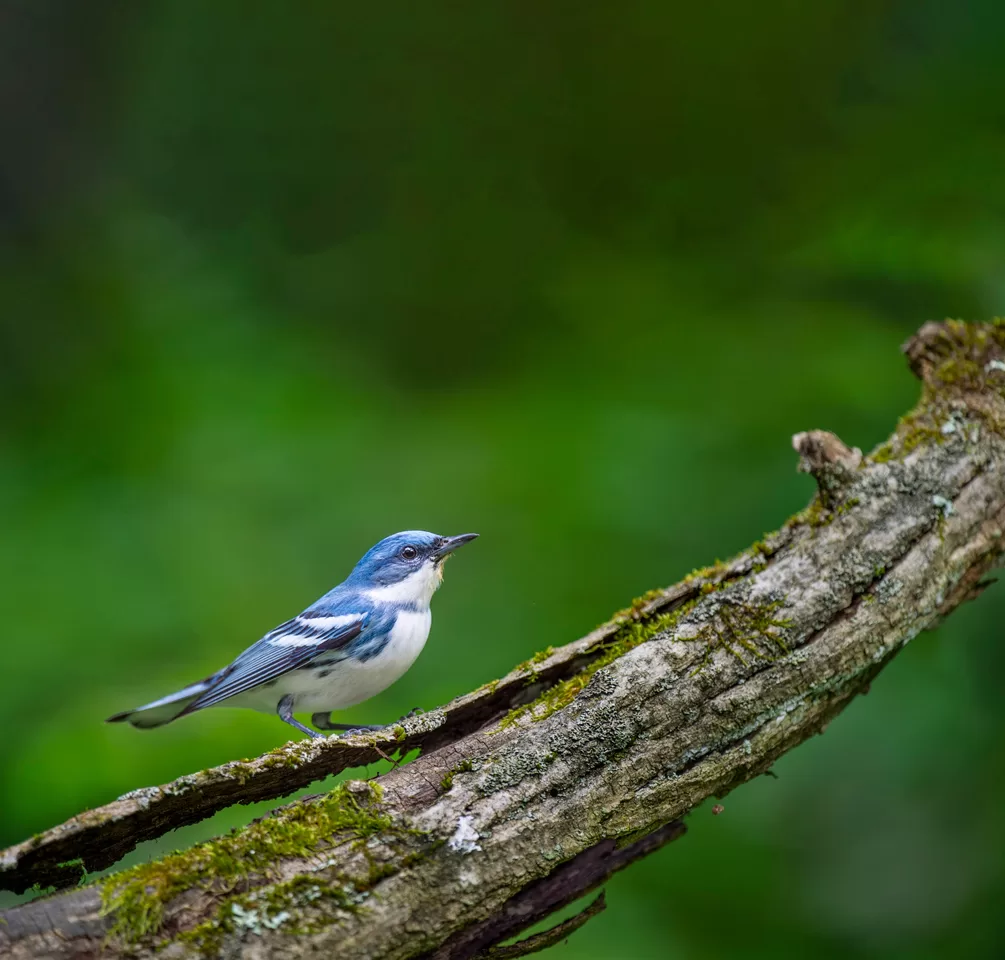Explore the differences between bird-watching and birding. While you may find you fit into the former category today, one bird sighting could change all that.
By Ann Bush, F516383
May 2023
My mornings usually start with a slow walk along a trail in an east Texas forest. Whether at home or traveling in my RV, binoculars are always within an easy swerve up to my eyes, ready to focus on anything that moves. Rustling leaves attempt to hide the purpose of my journey: the birds who are also waking up.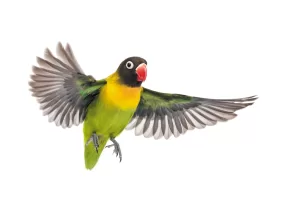
An innocent morning walk many years ago with an avid bird enthusiast who kindly explained the wonder of these winged creatures kindled an appetite within me for more.
Today, I know that the chirping tan bird with hints of pink is a female northern cardinal; the sweet singsong “tu-ta-tutatutatu” is a white-throated sparrow; and the petite, feisty bird bearing the colors of a winter sky against snow is a white-breasted nuthatch. As with any creature, the more you know about each other, the more intimate the relationship will be. Knowing details about birds has tremendously enhanced my favorite pastime. This basically is the difference between bird-watching and birding.
Hobby Versus Sport
According to World Birds, “bird-watching” means to watch birds from the comfort of one’s home, which would include an RV. For these folks, knowledge of the species of bird usually is limited to basics such as sparrows, cardinals, or wrens. Bird-watching is essentially a fun pastime or hobby.
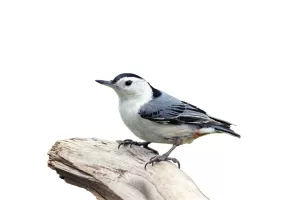
The white-breasted nuthatch is an active, agile little bird with a loud, recognizable voice
“Birding” is much more complicated, and the degree of the pursuit varies according to the watcher’s level of interest. For example, depending on who you ask, more than 45 sparrow species exist in North America, and they may all look alike to the untrained eye. A birder would know which sparrow is fluttering before them. Being able to properly identify birds, either by sound or sight, turns this casual hobby into a serious sport.
Birders go a step further by adding a competitive twist called a “life list.” A life list is basically a written record of how many different bird species a person has seen during their lifetime. The life list also documents where, how, and who spotted the bird, creating a tally of statistics for discussion. Get a group of birders together, and the dialogue will aim toward new research on binoculars, life-list totals, a superb or dreadful bird guide, bird species, and more. Spouses of birders who are not as enthusiastic as their better half are often called birding widows. Sound like football or baseball enthusiasts?
Why Go Birding?
Many reasons exist as to why a bird-watcher would want to up-grade their bird-watching skills to become a birder, one of them being bragging rights. Many late nights have been filled with hearty discussions comparing life-list totals. Sometimes we share “war stories” of how difficult locating a bird was. For example, my birding group in Ecuador loaded into our van at 4:00 a.m. to drive to a narrow trail on the side of a mountain in hopes of seeing the stunning cock-of-the-rocks leave their nests to hunt. The challenges of finding birds in the wild, without feeding them, is an amazingly addictive triumph. It vindicates a little bragging now and then.
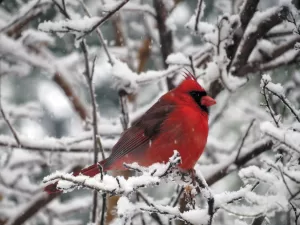
After a February snow, this male northern cardinal appeared in the author’s backyard in Texas.
You will most likely become a serious birder when you see your spark bird. This is the bird that steals your heart, takes your breath away, and is so amazing that you must know more. People usually are smitten with a bird’s beauty (or lack thereof) or its ability to survive in a harsh environment. I have always been fascinated by birds simply because they can fly.
However, my spark bird was Elmer, a small cerulean warbler that migrates from Maine for thousands of miles over the ocean to spend the winter in Colombia — and then flies back in the spring to the very same tree to start a family. Maybe this is why humans put wings on angels.
Another reason birding is popular is the health benefits it brings. Accord-ing to a New York Times article from December 12, 2022, “Spending time outdoors with a pair of binoculars is good for your body and soul.” Being outdoors has been proven to calm the nerves, clear the head, and improve mood. Birding usually requires a lot of walking in fresh air and sunshine, and it has been deemed a wonderful form of exercise for all ages.
The field of research is growing, and new findings reveal that birding may also improve cognitive functioning. “Birding With Benefits” by Jill U. Adams, found on the national Audubon website (www.audubon.org), refers to mounting scientific evidence that explains how birding can be beneficial to one’s mental health on a long-term basis. Particularly exciting is research concerning how serious birding could offset Alzheimer’s disease. It may be that exercising our memory brain cells at the level of detail found on a bird is more intense and beneficial than doing easier repetitive mental activities.
Birding may lead to extreme travel, as it opens the door to the non-tourist side of a place, aiming for wild, off-the-beaten-path sites where remarkable people and mind-boggling scenery are found. And using professional bird guides may open access to private farms; indigenous reservations; and secret hot spots in the middle of nowhere, which the guide will guard with CIA skills. When I travel in the United States, I contact local Audubon clubs for advice about birding hot spots and guides.
Birding 101
Buy a field guide. Ask a birder which field guide to use and you will get a variety of answers. I currently use the Peterson Field Guide To Birds Of Western North America and the Peterson Field Guide To Birds Of Eastern and Central North America. I purchase used field guides for each state or country I visit. There are good bird sites online, such as Merlin or eBird, but I love to scribble notes of sightings in my guidebooks, which become cherished travel journals.
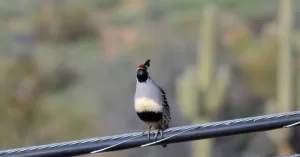
In Arizona, the author sighted a Gambrel’s quail , a species that frequents desert regions.
Get a pair of binoculars. Learn the proper way to use binoculars by watching a video on the national Audubon website, www.audubon.org. Next, visit local outdoor stores to learn about brands and models. Similar to when you ask someone what car to buy, birders will debate which binoculars are the best. Important factors to consider are level of eyesight (with or without eyeglasses), weight (ability to hold binoculars up to your eyes for more than 30 seconds), location (may need to be waterproof), and fashion and style. My best advice is to not spend a fortune in the beginning. The first set purchased is the perfect backup plan — like if a very expensive set is lost while riding on the back of a motorcycle on a bumpy dirt road in rural Colombia, when they fall out of an improperly zipped backpack, never to be seen again. I’m still grieving.
Focus on your local area. Find the website for a nearby state or federal park, and download their bird checklist, which is a list of birds found at that facility. This will be a good list of what birds to look for, since field guides cover larger areas and include birds never seen at your particular location. Take a short course in geography. One of the most important factors to locate and properly identify birds is knowing what habitat they prefer.
Join a club. Search for an Audubon Society chapter or other birding club that offers information, field trips, and camaraderie. Subscribe to magazines or join organizations that specialize in the bird world, such as Bird Watcher’s Digest, Audubon, and Bird Conservation. Along with important bird information and news, these organizations and their publications promote bird festivals around the United States. Having a venue in which to share your experiences with someone who understands is part of the fun.
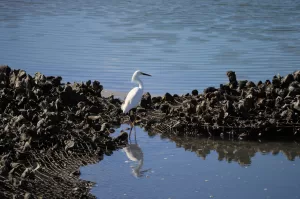
The snowy egret can be seen in coastal areas, especially places with mudflats and tidal wetlands.
You are ready now to go birding —to venture out among the wild and find a bird. However, there are unspoken rules you should know if you want to see wild birds. Statistics have proved that 30 percent or more of birds will flee at the slightest sound, even someone strolling through leaves. Bird feeder birds are less timid, but wild birds will be cautious, especially in spring during chick season when birds even stop singing so as not to draw attention. Putting your phone on vibrate, walking slowly without shuffling your feet, and whispering are essential.
When a bird graces your view, study its features and answer these questions: What is its size, tail shape, leg or foot color, beak trait, and distinctive markings? Refer to the field guide’s topography page and match the details to the color photos, and you have now properly identified your first life-list bird.
Hazards To Birding
If you find a pair of binoculars in the ditch, they probably belong to a birder trying to identify a sparrow. Just as with golf clubs, binoculars cost a fortune, and the calmed-down birder eventually will return for them.
Every morning walk, vacation, or trip to the grocery store will become a birding trip. You will end up buying at least two pairs of binoculars so one is always in the vehicle. You will talk about birds even when no one cares. You will lose friends but gain birders.
If You Go Birding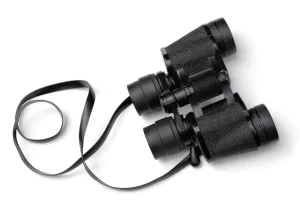
Make sure you have appropriate clothing for layering, as temperatures change throughout the day, or when walking from lower to higher elevations. Hats and comfortable waterproof boots are crucial. Most of my birding clothes were found in the fishing department.
Find a backpack or carry-on bag that is large enough for discarded clothing, sunscreen, field guides, snacks, water, non-spray insect repellent, and a roll of toilet paper. Do not spray insect repellent around binoculars, as it destroys the lens.
The best advice: Do not rush. Study one bird at a time, appreciate the journey, and discover the joy of birding.

